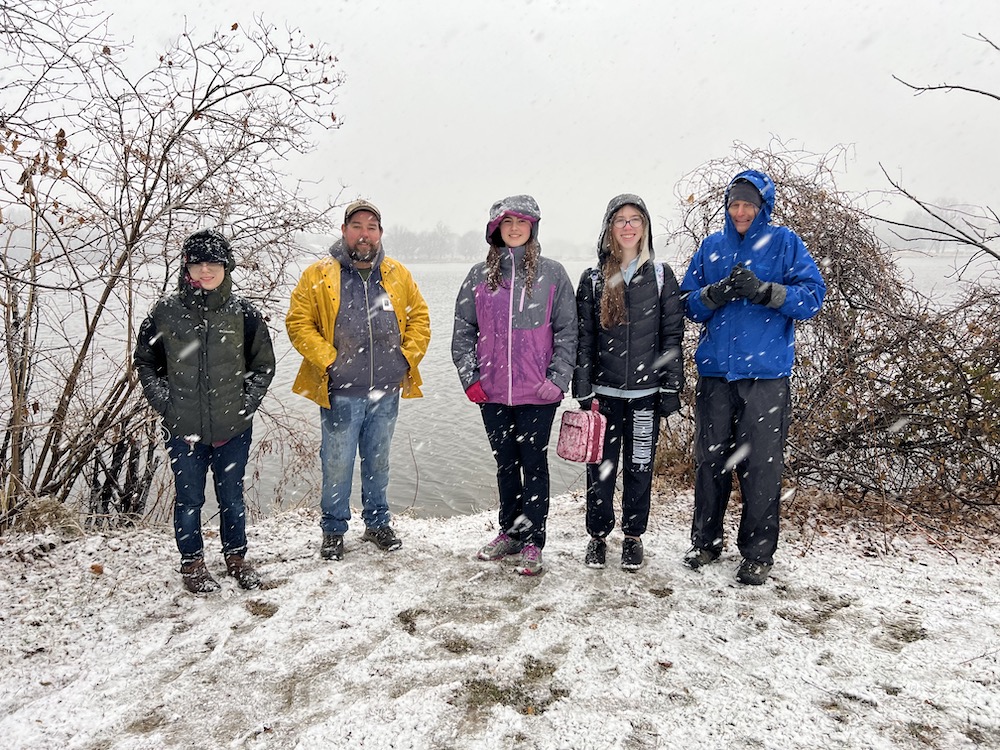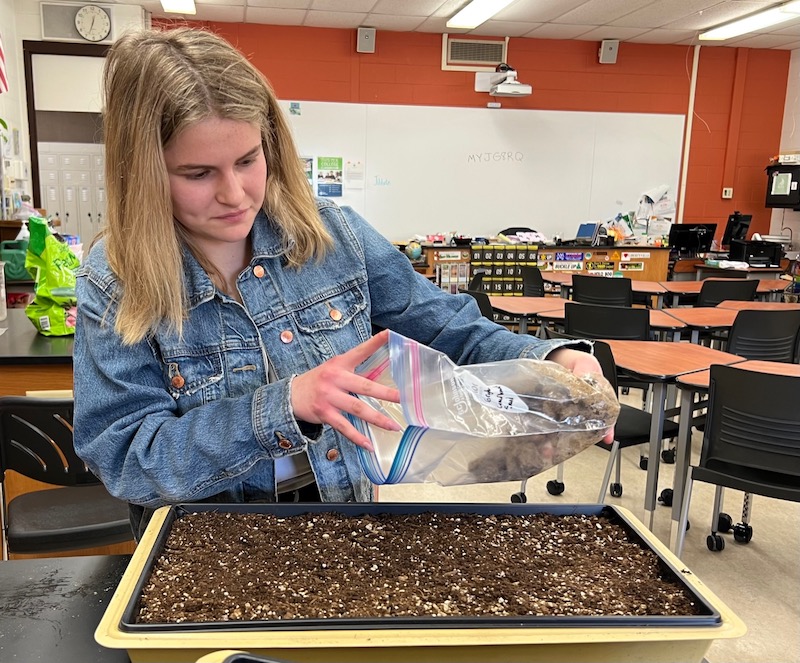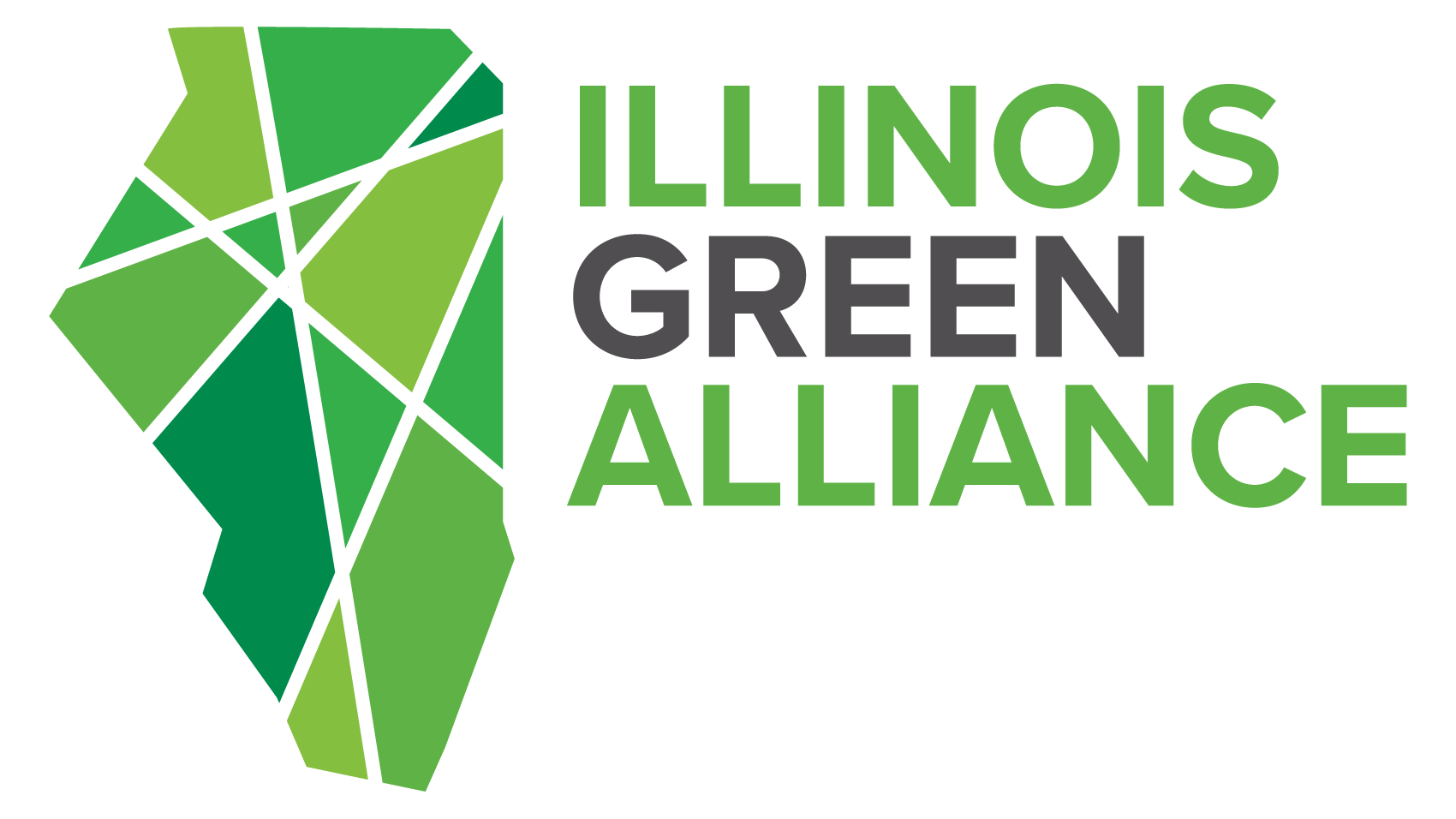
Libertyville High School: Butler Lake Southern Shoreline Restoration
- Project Type: Habitat Restoration & Biodiversity, Native Plant or Food Garden, Outdoor Learning Space, Stormwater management, Water
- Students: 150
- Staff: 14
- Mentor: Brianna Galvan
- Location: Libertyville, IL
- Grade Level: High School
The Project
Students at Libertyville High School researched, planned, and prepared a 300-foot native plant buffer strip between the school and Butler Lake. The native plants will help slow stormwater runoff by reducing sediments and pollutants from entering the lake. Environmental student groups plan to transplant the native plants this coming fall. Until then, the plants are growing from seed indoors in classrooms, as well as outdoors in a courtyard. Students have also removed invasive species from the shoreline to prepare the soil for native plants to be planted.
The project was led by students in ECOS club. The students researched the environmental issues, met with subject matter experts, decided on the focus of the project, presented the project proposal for approval, created a website, and propagated the native plants. Other student groups involved included LEAF club, AP Environmental Science, Special Ed, Fishing Club, and PE Department.
Goals of the project:
- Address shoreline erosion issues
- Improve lake water quality
- Remove invasive plants
- Create shoreline habitat for native species/migratory wildlife
- Reduce flooding on campus
- Educate homeowners about native plants, beneficial pollinators, and water management practices
The Process
Identifying Environmental Issues
Extreme rainfall in the summer of 2017 led to significant flooding of the Des Plaines River. Many of the neighborhoods near Libertyville were flooded, and people used kayaks to navigate the streets and help their neighbors. Butler Lake was also flooded, with water levels only a mere feet away from the back wall of the Libertyville High School.
An overgrowth of green algae-like plants surrounds Butler Lake, and that the shoreline of the lake has been eroding, leaving several stretches of the shoreline with only a few feet of ground between the practice football field and the water. The school also identified several invasive plants along the lakeshore, including European buckthorn.
Understanding the Underlying Scientific Fundamentals of Butler Lake Ecology
To better understand the flooding issues, faculty and students studied the 2015 Butler Lake Report for background information about the health of the lake. They learned that the “lake” is actually classified as a wetland, which is not as deep as a lake, and it is also considered temporary. Most of Libertyville High School was built on the floodplain, and under today’s laws, it wouldn’t be allowed to be built in its current location.
- Flooding: Flooding along the shoreline is expected because the land between the lake and the school is considered a floodplain, which is the flat land next to a body of water. Because a building really shouldn’t be built on a floodplain, the school will always face the threat of flooding, especially in the parking lot and sports fields.
- Erosion: The soil around the lake is slowly falling into the lake. The soil particles in the lake block sunlight from reaching the aquatic plants, and lower the water quality of the lake. The nutrients in the soil are considered to be pollutants for the water. The Environmental Protection Agency (EPA) considers the school’s watershed to be impaired (damaged) because of a high amount of particles (total suspended solids) and high concentrations of the nutrient phosphorus (total phosphorus).
- Invasive species: Looking at the data from iNaturalist, about half of the plant species that were identified along the shoreline were considered invasive species, and five of the species are considered invasive species of concern. They include: multiflora rose, Tatarian honeysuckle, reed canary grass, perennial sow thistle, and buckthorn. Invasive species have significantly decreased the biodiversity of the woodland habitat around Libertyville High School’s campus because they outcompete native plants for resources and they lack natural predators. Native plants provide the best habitat for local wildlife because the plants and animals evolved together and are adapted to use and share resources.
Considering Mitigation Options
Students researched options to help deal with the flooding, erosion, and invasive species issues, and consulted separately with seven different subject matter experts who came to the school to explain the issues and possible solutions. All of the experts were unified in recommending planting native plants along the shoreline as an important part of a solution to address the issues identified along the shoreline.
The deep-root structures of native plants act to anchor the soil leading to reduced runoff of nutrients into the late, reduced erosion (because shoreline plants absorb wave energy and hold the soil), filtration of water (which reduces pollutants from entering the lake), and the creation of habitat to support beneficial pollinators, migratory birds and local wildlife.
Selecting a Project Focus
With a limited amount of time in the school year, the school decided to focus the project this year on removing the invasive species along the shoreline. This prepares the site for planting native plants next year.

Seeking Approval
The students discovered that part of the shoreline was owned by the Village of Libertyville; not only The School District alone. Therefore, students had to seek approval from the Village of Libertyville before proceeding with the project. On December 6th, they presented their proposal to the Village’s Parks and Recreation Committee. The Trustees were excited about the project, and agreed to work with the School District to draft a legal agreement that would allow the school to work on their land.
The students also learned that they needed approval from the Village arborist because the large buckthorn are considered to be trees, and the Village needs to approve the removal of any trees ahead of time.
Finally, the students’ mentor at the Stormwater Management Commission informed the school that, because Butler Lake is considered a wetland, they would need approval to work on the shoreline from the Army Corps of Engineers, the agency in charge of protecting the wetlands. The approval process was a valuable learning experience about local government.
Prepping the Site
Mentors from the ecological restoration company, ILM-Environments, agreed to help students clear the brush using their machinery as a donation! They treated the area with herbicide, which is a necessary step before planting native plants in that area. The woody invasive species will need to be treated several times throughout the summer so that students can plant in the fall.
ILM-Environments also cleared the brush along the shoreline using a forestry mower, revealing the lake that was once hidden by dense buckthorn.
To prepare for the fall planting, students collected seeds from the native plants in the school’s courtyard, and other locations in the county, with permission from the landowners. They dried and prepared the seeds for storage, putting them in plastic bags with damp soil to simulate the conditions of winter. They did this because most native plant seeds require winter-like conditions before they will germinate.
In January 2023, students took the seeds out of the refrigerator and put them into germination trays under grow lights on racks in a classroom. When they sprouted, they transplanted them into pots.
Until late spring, the plants will remain indoors, then students plan to place the plants into bigger pots and move them outdoors for the summer. They anticipate that they’ll grow half of the plants needed for the shoreline; and use outside funding to purchase the other half. Some of the plants need to be purchased because they are difficult to germinate or require specialized care while they develop.
Looking forward
For the remaining school year, the students will continue to care for the potted plants, and they will plant the shoreline in the fall of the upcoming school year.
Students involved in this project are planning to invite students and staff to help them plant and spread the sense of ownership and pride in the new shoreline, and to educate as many people as possible about the importance of native plants.
They also hope to install an informational sign on the shoreline to continue to teach the public about native plants and to encourage landowners to incorporate native plants into their landscape design.
